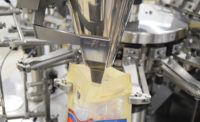Packaging is becoming a more powerful element in the push by processors to enhance product appeal.
Indeed, dairy product developers are increasingly leveraging rigid and flexible packages that enable the operators to keep pace in a hyper-competitive sector by enhancing freshness and food safety, while improving shelf appeal. It is resulting in an ongoing development of innovative designs by packaging suppliers.
“The growing focus of dairy manufacturers on capturing a share in the global dairy trade through best-in-class international export and local production capabilities has fueled the demand for better dairy-based packaging solutions,” reports Mordor Intelligence, a Hyderabad, India-based market research firm. “The primary factor behind the expansion of sales of dairy products is the different types of packaging available nowadays.”
Mordor notes that the growing consumption of dairy products through a variety of retail channels “is likely to boost the dairy packaging market in the country.”

The dairy evolution has included a move from glass bottles to polyethylene pouches, paperboard cartons, and tins, to tetra packs and aluminum cans. Leading product manufacturers continue to introduce selections in innovative and convenient packaging formats, including clear tubs and squeezable pouches, states Dublin, Ireland-based Research and Markets. Some brands, the firm notes, also are merchandising yogurt in high-density polyethylene (HDPE) plastic bottles sealed with either aluminum foil, laminated heat-seal closures, or low-density polyethylene (LDPE) plastic caps or lids to protect the contents from oxidation and delay the fading of light-sensitive colors.
In addition, dairy suppliers are offering modified atmosphere packaging (MAP) with aseptic and antimicrobial properties that helps extend the shelf-life of dairy products up to 90 days under refrigeration storage by controlling the associated fungal contamination, Research and Markets states. More sustainable designs also are hitting store shelves. “With rising environmental concerns, the leading dairy companies are adopting eco-friendly packaging to reduce their environmental impact and to preserve natural resources,” the research firm notes.
An ongoing evolution
Pent-up interest from the leading packaging innovators to challenge the industry status quo and bring consumer-requested enhancements into fruition is helping to drive improvements, says Glenn Emory, general manager — North America, for Weidenhammer New Packaging LLC, a Kansas City, Mo.-based packaging supplier. He notes, for instance, that bulk ice cream packaging alternatives have been expanding to include non-metal containers that reduce the risk of cuts to users and the subsequent wasting of product because of exposure to blood-borne pathogens.
Consumer-driven innovations also include the use of more transparent materials so shoppers can view products in packages, along with zippers and resealable film to enhance freshness, says Ryan Spencer, product market manager, chamber machines, slicing and portioning, for Multivac, a Kansas City, Mo.-based packaging machine developer.
A greater variety of sustainable packaging options are available as well, notes Ethan Crist, market development manager, food packaging, for Klöckner Pentaplast Group, a London-based packaging supplier. “Consumers want to know that the packaging they touch has a good story,” he states.
“Consumer education and awareness around sustainability in packaging has grown dramatically, fueled by far greater information coming from traditional as well as social media,” adds Tim Kieny, vice president of marketing, dairy, protein, and pet, for TC Transcontinental, a Montreal-based flexible packaging provider. “Equally important to consumers is recyclable packaging as well as the use of recycled materials.”

The ideal packaging solutions, meanwhile, will differ from processor to processor, and even within an operation from product to product, Spencer says. Indeed, he notes that specific packaging strategies should vary in accordance with a processor’s target market and unique brands.
Costly high-recyclable material, for instance, might not suit a high-volume/low-cost SKU, Spencer says, but may work for an audience that is sensitive to packaging’s environmental impact.
Product characteristics also dictate packaging preferences, Emory states. He notes, for instance, that plastic pails often are best for products with less viscosity, such as some sherbets, as the legacy metal ring drums tend to leak. He says that packaging costs and the amount of interest in driving innovation also can influence choices. “There is never a singular ‘winner’ in considering a package design,” Emory explains. “Packages will all have points of relative strength and areas of weakness. That balance will take on importance depending on the strategic imperative of the business.”
Establish technological parameters
In pinpointing the optimal packaging for their specific circumstances, processors should consider if the packaging serves the messaging of the brand; if they will be able to leverage the design consistently and safely; and if it will help the consumer find and enjoy the product, Multivac’s Spencer says.
Packaging systems also should adhere to the necessary safety and sanitary standards and be manufactured with the desirable speed, payload, footprint, and level of automation, says Ryan Womble, sales director for Covington, Ky.-based ProMach Inc.’s Quest brand of packaging equipment.
This includes having systems that can effectively perform in harsh operating environments, including areas that are wet, cold, and subject to cleanings, adds Josh Nelson, marketing manager for Engage Technologies Corp., a Brooklyn Park, Minn.-based packaging equipment developer.
The appropriate packaging for each process will differ in accordance with market needs as well, Klöckner Pentaplast Group’s Crist says, noting that “what will contribute positively to a consumer choosing your product should drive all other decision making.”
As a result, processors should leverage innovations that can provide a competitive edge, such as packaging with smart labels, sustainable materials, and state-of-the-art printing, says Eddie Kingston, quality manager for Overnight Labels Inc., a Deer Park, N.Y.-based provider of package printing solutions. “While marketing and functionality play a role, most dairy products are highly perishable, so shelf stability and food safety are also crucial areas for processors to consider,” he states.

Implementation can be arduous
Leveraging the preferred packaging technologies, however, can be difficult. Processors, for instance, still must have the necessary space within facilities to house the equipment along with the required capital. “Sometimes it is easy to chase the ‘perfect package’ without stepping back and evaluating how your organization will support the execution,” Spencer says.
In addition, installing automated packaging lines, which are intended to provide greater operating efficiencies while solving labor issues, might necessitate the use of dedicated training teams, he notes. Therefore, Spencer stresses that packaging supplier should offer local service and parts support to keep lines operating at peak performance.
Internal corporate issues, such as a reluctance by risk-averse processors to change their operating and packing methodologies, can further delay packaging enhancements, according to Weidenhammer’s Emory.
Indeed, overcoming inertia might be the biggest obstacle that is preventing processors from changing technologies. “It’s hard to switch packaging as there are multiple stakeholders, not to mention the need for line and shelf-life trials, and consumer panels also are often involved,” Crist notes, suggesting that not all product lines generate margins that can support a packaging system overhaul.
Yet, to be successful, there must be a willingness by processors to take calculated risks, as well as a need to partner with suppliers that can present available options and packaging innovations, Emory states. “Not every company needs to be ahead of the curve, but you can’t afford to be behind the curve,” Crist adds. “Watch where the traffic is going.”
Despite the reluctance of some processors to upgrade or switch packaging systems, most operators still are likely to benefit from modifications, Engage Technologies’ Nelson points out. “Customers often regret waiting so long to make a necessary change,” he notes, adding that a common processor quote is, “I wish we would have done this years ago.”
As packaging equipment continues to improve and increase in flexibility, user segment needs are being met. Automation is key, as automated solutions enable processors to more quickly and effortlessly make packaging changes, which can result in greater production throughput while reducing consumable costs, Nelson adds.
“This is where automated packaging provides incredible value,” Pro Mach’s Womble says. “It eliminates the need for manual labor and the possibility for human error, which makes the dairy packaging process consistent and repeatable.” Automated options include robotic picking systems that enable processors to load, orientate, stack, and group products into a variety of primary packaging machines, such as thermoformers, flow wrappers, and vacuum sealers, he states.

Pick the right partner
Processors, meanwhile, should consider both current and future needs when deciding on packaging systems, TC Transcontinental’s Kieny says, pointing out that effective suppliers are “on the cutting edge of packaging technology and sustainability and will bring the latest developments in packaging.”
Operators also should confirm that their suppliers are well-stocked with the necessary equipment and materials to maintain the desired operational efficiencies, Overnight Labels’ Kingston says. “If you foresee a potential issue, it’s important to know that the supplier has a plan B that won’t impact the packaging integrity and ship date,” he states. This is crucial since industry-wide supply chain issues over the last few years have prevented some processors’ from obtaining their ideal packaging, Kingston adds.
“Shortages, long or delayed lead times, and being forced to choose a lower-quality available packaging material have impacted production deadlines, causing empty shelves and disappointed consumers,” Kingston states.
However, with supply chains strengthening, more processors are in position to leverage packaging systems that allow them to provide enhanced value to their customers while also driving positive bottom-line performance for themselves, Weidenhammer’s Emory concludes.



